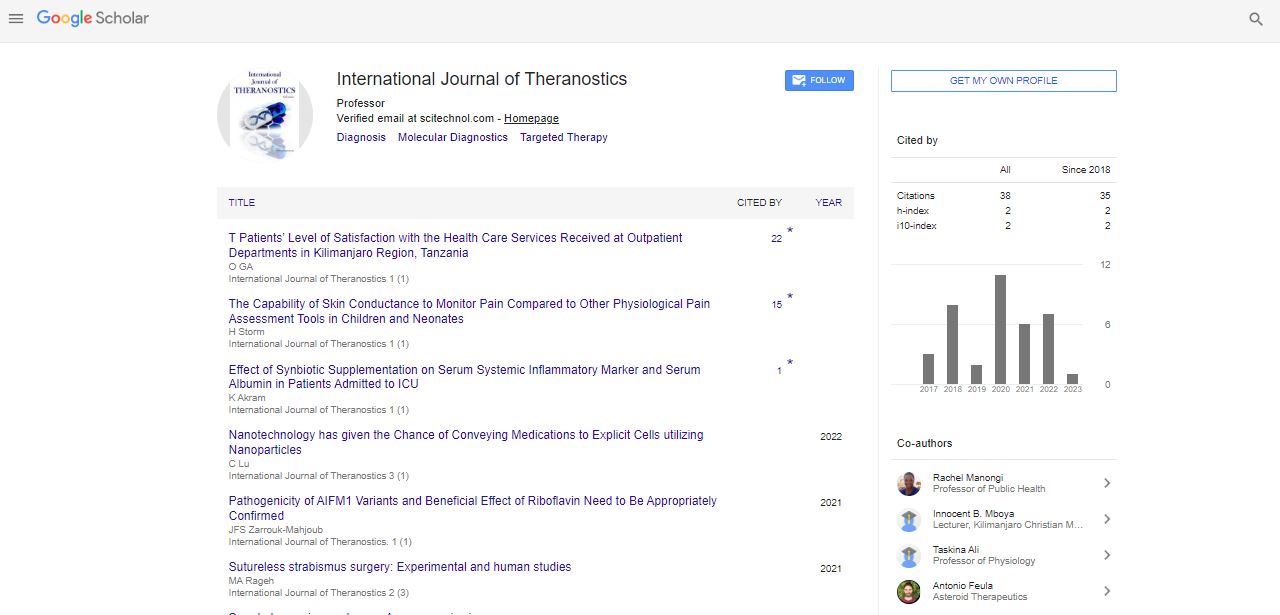Commentary, Int J Theranostic Vol: 12 Issue: 4
Theranostic Approaches in Environmental Health: Detecting and Mitigating the Impact of Pollutants on Human Health
Xin Xinbo*
1Department of Pharmaceutical Engineering, Shenyang Pharmaceutical University, Shenyang, China
*Corresponding Author: Xin Xinbo,
Department of Pharmaceutical
Engineering, Shenyang Pharmaceutical University, Shenyang, China
E-mail: Xxinbo87744@shpu.cn
Received date: 27 November, 2023, Manuscript No. IJT-23-124072;
Editor assigned date: 29 November, 2023, PreQC No. IJT-23-124072 (PQ);
Reviewed date: 14 December, 2023, QC No. IJT-23-124072;
Revised date: 21 December, 2023, Manuscript No. IJT-23-124072 (R);
Published date: 28 December, 2023, DOI: 10.4172/IJT.1000150.
Citation: Xinbo X (2023) Theranostic Approaches in Environmental Health: Detecting and Mitigating the Impact of Pollutants on Human Health. Int J Theranostic 12:5.
Description
The field of environmental health faces unprecedented challenges as human activities continue to alter the composition of our surroundings. Pollution, resulting from industrial, agricultural, and urban practices, poses significant threats to both ecosystems and human health. In this context, theranostic approaches, which integrate diagnostics and therapeutics, emerge as powerful tools to detect and mitigate the impact of pollutants on human health. This essay explores the application of theranostic approaches in environmental health, focusing on the detection of pollutants and the development of targeted interventions to safeguard human well-being.
Theranostic approaches in environmental health often begin with robust diagnostic tools. Biomonitoring, involving the analysis of biological samples for the presence of pollutants, provides valuable insights into human exposure levels. Biosensors, equipped with biorecognition elements, enable real-time monitoring of pollutants, offering a timely assessment of environmental quality and potential health risks. Genomics, proteomics, and metabolomics play a pivotal role in understanding the impact of pollutants at the molecular level. These omics technologies allow researchers to identify biomarkers indicative of exposure to specific pollutants and assess their potential health effects. Integrating omics data into theranostic approaches facilitates a comprehensive understanding of the intricate relationships between pollutants and human health.
Advanced imaging technologies, including satellite-based remote sensing and ground-based imaging, contribute to the diagnostic armamentarium in environmental health. These technologies enable the visualization and mapping of pollutant distribution, aiding in the identification of pollution hotspots and informing targeted interventions. Nanotechnology offers innovative solutions for remediating environmental pollutants. Nanomaterials can be designed to capture, degrade, or immobilize pollutants, providing efficient and targeted remediation strategies. Theranostic nanoparticles equipped with diagnostic capabilities can monitor the effectiveness of nanoremediation in real-time.
Harnessing the natural abilities of plants (phytoremediation) and microorganisms (bioremediation) represents a sustainable approach to pollutant removal. Theranostic tools can be applied to optimize these processes, ensuring the efficient uptake and transformation of pollutants by plants or microbes. Monitoring tools provide valuable information on the success of these remediation strategies.
In cases where pollutants have adverse health effects, theranostic approaches can involve targeted drug delivery to affected individuals. By identifying biomarkers indicative of pollutant-induced health risks, therapeutic interventions can be tailored to mitigate specific health impacts, ranging from respiratory diseases to neurotoxic effects. Environmental systems are inherently complex, with numerous interacting factors influencing pollutant dynamics. Developing theranostic approaches that can accurately capture this complexity poses a significant challenge. Integration of diverse data sources and interdisciplinary collaboration are essential to address this complexity.
Environmental pollutants are often present as mixtures, and their combined effects may be greater than the sum of individual impacts. Theranostic approaches need to account for the synergistic effects of pollutant mixtures, requiring sophisticated analytical tools and predictive models. Environmental health challenges extend beyond geographical boundaries, making it a global concern. Theranostic approaches must be adaptable to diverse environmental contexts and tailored to address region-specific challenges. International collaboration and data-sharing mechanisms are crucial for the success of global theranostic initiatives.
Ongoing advancements in sensing technologies, including miniaturized sensors and Internet of Things (IoT) devices, offer opportunities to enhance the diagnostic capabilities of theranostic approaches. These technologies enable real-time, continuous monitoring of pollutants, providing a dynamic and comprehensive view of environmental conditions. Machine learning algorithms and data analytics play a crucial role in processing vast datasets generated by theranostic approaches. These tools can identify patterns, predict pollutant trends, and optimize remediation strategies. Machine learning applications contribute to the development of intelligent theranostic systems for environmental health.
Conclusion
Theranostic approaches in environmental health represent a holistic strategy to address the complex challenges posed by pollutants to human well-being. By combining diagnostic tools with targeted therapeutic interventions, these approaches offer a dynamic and personalized response to environmental health issues. From biomonitoring and biosensors for pollutant detection to nanotechnology-based remediation and targeted health interventions, theranostics contribute to a comprehensive framework for understanding, preventing, and mitigating the impacts of environmental pollutants.
Challenges such as the complexity of environmental systems and the global nature of environmental issues underscore the need for continued research, technological innovation, and international collaboration. Opportunities presented by advancements in sensing technologies, machine learning, and community engagement position theranostic approaches as essential tools in the pursuit of sustainable and resilient environmental health solutions. In the face of a changing environment, theranostics emerge as a beacon of hope, offering a path towards a healthier and more resilient future for both ecosystems and human populations.
 Spanish
Spanish  Chinese
Chinese  Russian
Russian  German
German  French
French  Japanese
Japanese  Portuguese
Portuguese  Hindi
Hindi 